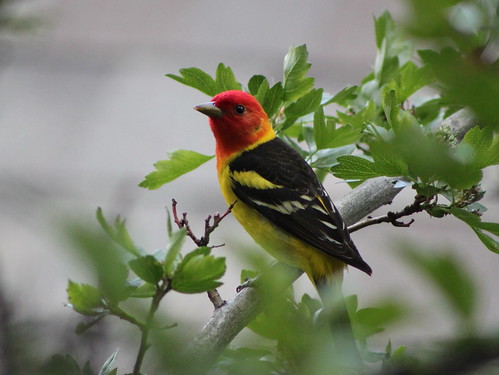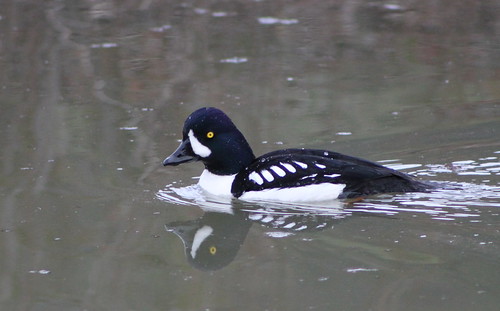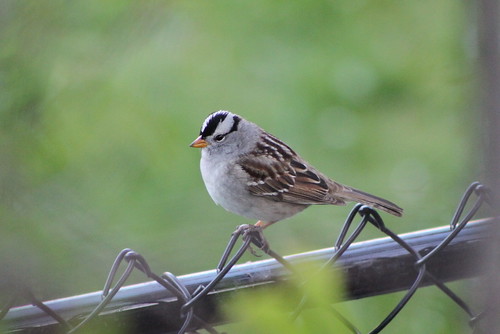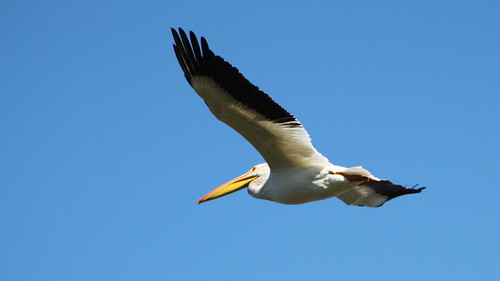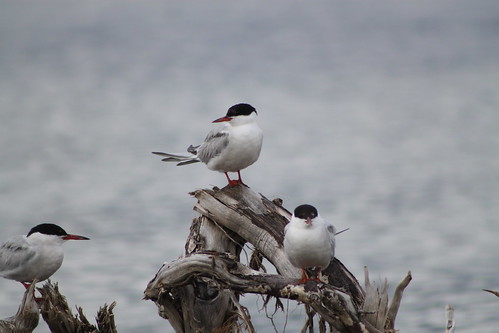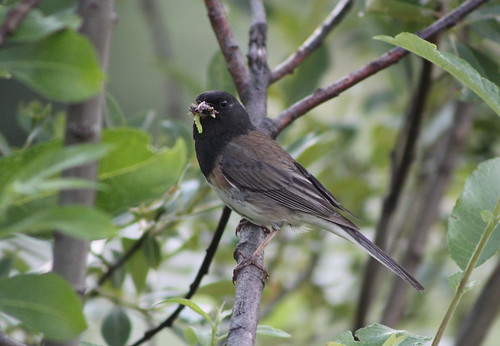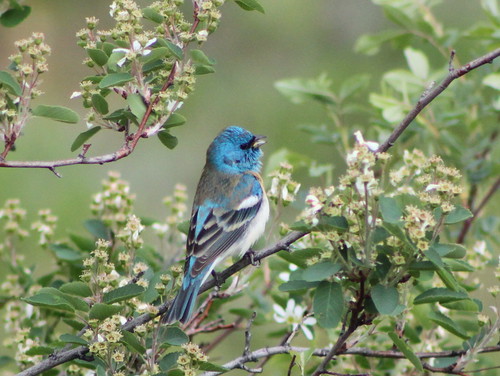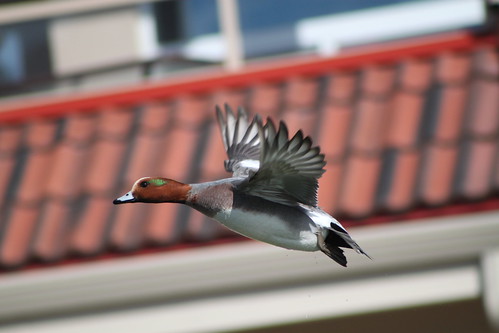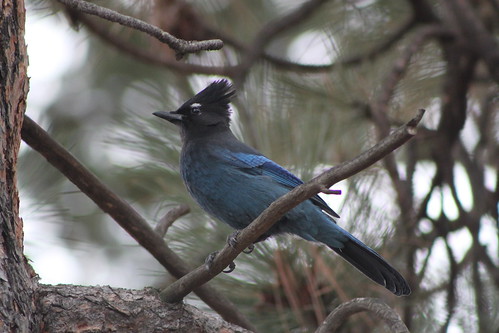Yesterday, we birded at Munson Pond and Sutherland Hills Park, two fantastic birding spots in Kelowna.
We started at Munson Pond, which is a migrant trap in migration, especially in fall, where uncommon sparrows love to stop by. Rarities here are annual and some good birds spotted here in its history are : Sage Sparrow, American Bittern, and several Eurasian Wigeons in the winter. By late September, a few Greater White-fronted Geese *should* be passing through, resting on the large wooded pond with the hundreds of Canada Geese. But this year, they STILL haven't arrived yet, a delay of almost a month. That trend continued today.
Well, we started at the end of Munson Road, which leads to the pond. This stretch of farmland and bushes / trees host a variety of migrants, especially warblers and sparrows. In fact, a couple weeks back, I got a Clay-colored Sparrow mixed in with 5 kinds of warbler in a resident's yard's bushes. ( Please don't qualify me as a peeping tom. ) Oh, well. Today, when I got out of the car, I scanned the farm fields for a GRWHFRGO among the hordes of Canada to no avail. But by one of the fences, in a scraggly area, I was greeted with a ton of White-crowned Sparrow ( 90% juvenile ), and several Yellow-rumped Warblers. Many Song Sparrows were calling, and horde of Red-winged Blackbirds and European Starlings zipped by. Three Red-tailed Hawks were surveying their usual territories, as was a little flock of Black-capped Chickadees. A few minutes later, I detected some Dark-eyed Juncos chipping in a thicket. California Quail were everywhere as they always are. Just as a side note, even though the California Quails are introduced from California, our Okanagan population is the densest in the whole world! Back to the birding. Along the way, I heard a Wilson's Warbler; they are starting to get scarce this late in the season. Adjacent to the calling warbler, there was a nice Dark-eyed Junco of the Slate-colored variety. Uncommon, and always great to see, I tried to snap some shots, but they were only half-decent.

( Slate-colored ) Dark-eyed Junco
As I reached the pond itself, a Belted Kingfisher stormed over in a fury for no apparent reason; flying away from the pond. "Yo, kingfisher! The water's over here!" Chattering away, he was all but polite. On the pond there were dozens of Mallards and Canada Geese, not to mention a huge horde of American Crows cawing their beaks off beside the water. Three Pied-billed Grebes were fishing pleasantly near the shore, and one caught a fish that looked too big for his little bill. Nonetheless, he/she harfed it down. Surprisingly, no more waterfowl except one Wood Duck were counted. Usually there are loads of wigeons, teal, shovelers, Ring-necked Ducks, both mergansers, and more. But, not to be discouraged, I searched the tangles of brush on the left side, right by a tiny creek bed. I immediately saw a suspicious sparrow flush up from the brush, leaping to a bush on the other side. I flushed him again to the other side, but he wasn't cooperating. Finally, I got a good look at him : White-throated Sparrow! Then another popped up. The same two rare White-throated Sparrows that I got last week at this very spot! How ironic! One of the pair was being uncooperative, probably the one I saw flash across the road. The other meanwhile, was being a little better behaved. He was scrambling from branch to branch, calling profusely all the while. After 15 minutes, and a lot of pishing and imitating on my part, the sparrow finally plopped onto a branch in full view. The bird was so back-lit, I could swear someone was holding a flash-light on the other side of him. Being the determined photographer I am, I shot many photos his / her way and here are three :

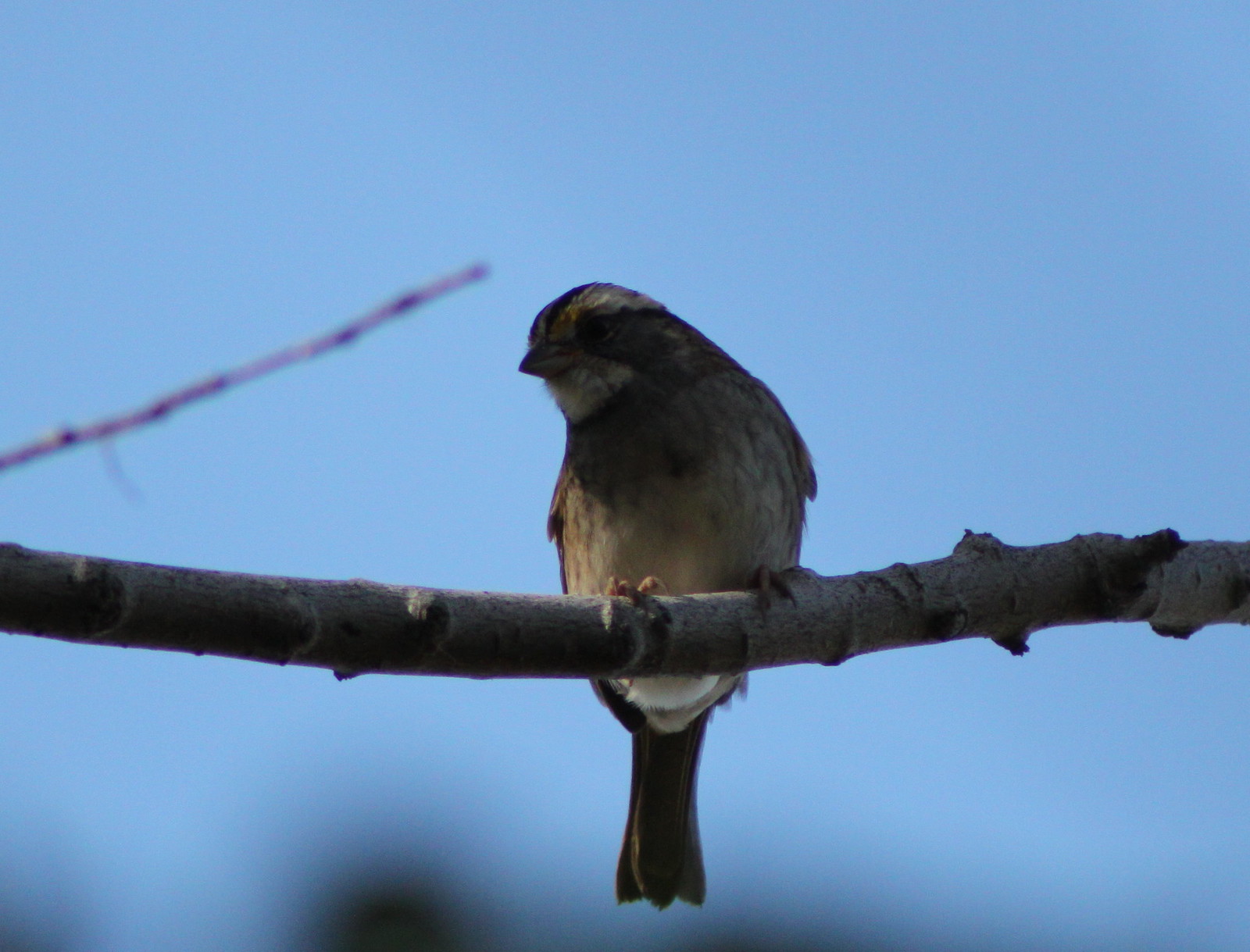
Note : the rest of the pictures came out smaller for some reason. Does anybody know why? I tried to adjust the size, but it wouldn't let me. Sorry.
White-throated Sparrow
In this section there was also an abundance of Ruby-crowned Kinglets. They were virtually everywhere. They were bouncing off the walls if you know what I mean. Here's two crazy pictures of the crazy kinglets being crazy :
After the fun with the Ruby-crowned Kinglets, I directed my attention to a nice Orange-crowned Warbler of the Gray-headed ssp. This is the best I could manage of the cutie.
Pardon the photo, he blends into the background quite easily. Here's a cropped version of it :
Orange-crowned Warbler
The way back to the car was overall birdless, with the same birds noted before. That's right, no Greater White-fronted Geese.
Next stop, Sutherland Hills Park. Under a time constraint, we didn't want to be pokey ( eg. Staring at a wee little ant for ten minutes. ) Can ( the verb ) the corny sense of humor, me! As we rounded the bend to the parking lot, we noticed an outrageous amount of people everywhere. Oh, boy; people are birders worst enemies in the field for many, many reasons. I hoped when we got up into the park ( which is at the top of a hill ) we would lose the human traffic. Okay, I'll back up. Sutherland Hills Park is a huge pine forest situated right by the locally famous Mission Creek, and smack dab in the middle of the city. The birds love it up there, as there are many species that breed there. Migration is good too, trapping a whole whack of tanagers, flycatchers, and warblers. The wooded ponds up at the top are host to the Central Okanagan's largest breeding population of Wood Ducks, and the conifers often have a Great Horned Owl's nest. Rarities here include : Ferruginous Hawk, Great Egret, and Magnolia Warbler.
When we got to the top, we were greeted by.................... more people. But thankfully, as we continued walking, the crowd started to dissipate. Typical piney-woods suspects started to make themselves known, such as Pygmy Nuthatch, Northern Flicker, and Dark-eyed Junco. The birding was quiet until we got to an excitingly active patch of pine-lover species. First I heard a bunch of Golden-crowned Kinglets peeping away, and more Pygmy Nuthatches were going nuts. Ascending two separate trees was a pair of Brown Creepers, a winter resident in the Okanagan. I guess they are back and ready for the winter season, sensing the crispy-cold air that's been swirling around these last few days. Black-capped Chickadee were everywhere in this patch too. After a while, the GC Kinglets were getting tired of our staring eyes, so they bounced on their happy way; dashing to a farther away tree. The creepers were out of view now also, so we continued on. Around the next curve, which leads to a kind of meadow, an amiable Downy Woodpecker sauntered overheard, providing great, but brief looks of this charismatic tree-pounder. In the Downy's case, "tree-tapper."
Crossing the small field, nothing was moving except for a few Song Sparrows, and a circling Red-tailed Hawk. Then we walked for while, and not much was really anywhere. Only four Mallards in one of the ponds, a pair of Black-billed Magpies, four Ruby-crowned Kinglets, and some American Robins were to report. At the back of the park, where we had worked ourselves to, was a short, but very steep hill. On this hill, there is a pond on the left side, and a wide, open field on the right. I always thought this would be an ideal place for sparrows. It had never been until today. What sparked my interest was a juvy White-crowned Sparrow that flushed out of a bush on the left hand side and stirring up a Dark-eyed Junco on the other side of the path. Then I noticed a sparrow behind the junco, which had now gone onto the path, feeding on the ground. This sparrow was very light and very sleek and slim, with a long tail. My binoculars shot up to my eyes, and I got fairly good looks at it. I said, "Oh, my goodness, I think it's an American Tree Sparrow! " Not daring to go closer, I watched it forage along the ground, hopping across the trail with the junco and White-crowned Sparrow. It turned around, showing me its side view. Picture time for confirmation!

American Tree Sparrow
Cropped
Original size. The ATSP is on the right beside a White-crowned Sparrow.
To further confirm it for me, the blessed little bird uttered a flight call, and sat in perfect light, straight facing me for a split second. The sparrow showed me it's rich reddy face pattern, buffy chest, and central breast spot. It also showed me it's black top mandible and yellow lower mandible. American Tree Sparrow indeed!
BC Lifer #275, BC year list #261
Okanagan Lifer #243, Okanagan year list #235
BC + Nevada lifer #317, Overall year list #302
I'm a happy camper!
Well, that's my day report; I hope you liked it! Many more to come.
